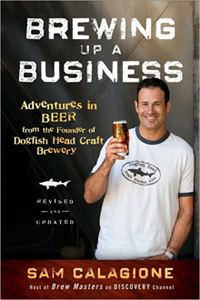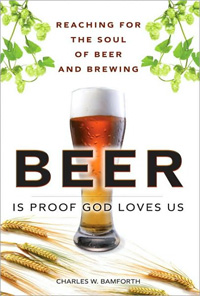 Intentions being intentions, not all 600 or so breweries currently “in planning” in the United States will end up brewing beer. But a little advice seems in order.
Intentions being intentions, not all 600 or so breweries currently “in planning” in the United States will end up brewing beer. But a little advice seems in order.
Although the combination might seem curious, “Brewing Up a Business: Adventures in Beer from the Founder of Dogfish Head Craft Brewery” (Revised and Updated) and “Beer Is Proof God Loves Us: Reaching for the Soul of Beer and Brewing” make a pretty educational one-two punch for an aspiring brewery owner.
The former comes from Sam Calagione, Dogfish Head founder-owner, and has earned plenty of praise from those who work outside a world populated by brewing kettles and cases of beer. Bob Guccione Jr. from Spin magazine, Jim Davis of New Balance and a former governor of Delaware are among those offering back cover blurbs.
It wouldn’t be one of Amazon’s best sellers in a category like Books > Business & Investing > Small Business & Entrepreneurship > Hospitality Businesses were the target audience only those selling beer. But it is rich with examples related directly to making and selling beer and written in a conversational tone. Calagione includes enough off-centered stories to make the book popular with fans of the brewery, and its founder, people with no interest in starting their own brewery.
Calagione wrote the first edition in 2005, so this update was in order. Not so much to reflect that Dogfish brews much more beer these days, but provide more about marketing, and particularly social media.
The book is long nuts and bolts. He goes into detail, for instance, about plans to sell $51 million worth of beer in 2011, running through the roster of just how many salespeople are involved and compensation packages.
 It makes an interesting contrast to “Beer Is Proof God Loves Us,” which offers philosophy from Charlie Bamforth, “the beer professor” better known for well, professorial, books. Like “Standards of Brewing: a Practical Approach to Consistency and Excellence.”
It makes an interesting contrast to “Beer Is Proof God Loves Us,” which offers philosophy from Charlie Bamforth, “the beer professor” better known for well, professorial, books. Like “Standards of Brewing: a Practical Approach to Consistency and Excellence.”
A native of England, Bamforth has worked for large breweries, in brewing research and was selected the first Anheuser-Busch Endowed Professor of Malting and Brewing Sciences at UC Davis. Bamforth makes his way toward “God in a Glass” (the 10th chapter) with stories that should appeal to the most ardent “craft beer” fan. He keeps things moving by employing end notes, which in total make up about half the book and are full of both short clarifications and long colorful stories.
But he doesn’t pander. For instance, he explains why a newly educated brewer might be much happier working for a very large brewery . . . while expressing concern about the number of jobs that actually may be available as those big breweries grow ever more efficient. He devotes a chapter to “So What is Quality” and does not deduct points when technically proficient beers strive to “reach the common denominator.”
He would be on the same side of the table as Calagione at one of those beer versus wine dinners. (In fact, I previously reviewed Bamforth’s “Grape vs. Grain’ and Calagione’s “He Said Beer, She Said Wine” in the same post.)
In the introduction (which itself merits 13 end notes), Bamforth writes, “The world of beer is hugely different from that I first glimpsed as a too young drinker close to the dark satanic mills of my native Northern England. has beer, I wonder, lost its soul?
“Or is it, rather, me that is the dinosaur? Is the enormous consolidation that has been the hallmark of the world’s brewing industry for decades nothing more than business evolution writ large as survival of the fittest? Do the beers that folks enjoy today . . . speak to a new age of Kindle, Facebook, and fast food?
“In truth, there remains much of his hoary old traditionalist to delight in: the burgeoning craft beer sector in his new motherland, the United States. A growing global realization that beer, rather than wine, is the ideal accompaniment to foods of all types and (whisper it) is actually good for you, in moderation.
“All is not lost in the world of beer.”


 Pierre Celis died Saturday. He was 86 and best known for resurrecting the Belgian White “style” and an otherwise extraordinarily engaging gentleman whose influence cannot be overstated.
Pierre Celis died Saturday. He was 86 and best known for resurrecting the Belgian White “style” and an otherwise extraordinarily engaging gentleman whose influence cannot be overstated. Jay Brooks has announced the topic for Session #51, and volunteered to host Session #51.5 as well. He calls it
Jay Brooks has announced the topic for Session #51, and volunteered to host Session #51.5 as well. He calls it 